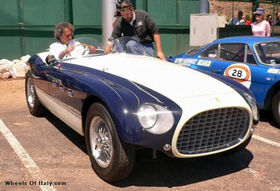Difference between revisions of "Ferrari 212 Export"
m |
m |
||
| Line 1: | Line 1: | ||
{{X}} | {{X}} | ||
| − | {| border=1 cellspacing=3 cellpadding=4 style="float:right; margin:0 0 .5em 1em; width: | + | {| border=1 cellspacing=3 cellpadding=4 style="float:right; margin:0 0 .5em 1em; width:280px; background:#505050; border-collapse:collapse; border:1px solid #999; font-size:83%; line-height:1.5; " summary="Infobox Automobile" |
|- style="text-align:center; background:#505050;" | |- style="text-align:center; background:#505050;" | ||
| − | | colspan=2 style="padding:0; background:#333333; color:#fff; border-bottom:1px solid #999;" |[[Image:of=50,590,444.jpg| | + | | colspan=2 style="padding:0; background:#333333; color:#fff; border-bottom:1px solid #999;" |[[Image:of=50,590,444.jpg|280px]] |
|- style="color:#fff; background:darkred; font-size:larger;" | |- style="color:#fff; background:darkred; font-size:larger;" | ||
! colspan=2 |'''Ferrari 212 Export''' | ! colspan=2 |'''Ferrari 212 Export''' | ||
| Line 19: | Line 19: | ||
|- | |- | ||
|Engines||2.3 L ''[[Ferrari Colombo engine|Colombo]]'' [[V12]] | |Engines||2.3 L ''[[Ferrari Colombo engine|Colombo]]'' [[V12]] | ||
| + | |- | ||
| + | | colspan=2 style="padding:0; background:#333333; color:#fff; border-bottom:1px solid #999;" |<videoflash>BtQNw2hVrBc|280|200</videoflash> | ||
|} | |} | ||
Revision as of 22:03, 13 October 2009

| |
| Ferrari 212 Export | |
|---|---|
| Manufacturer | Ferrari |
| Class | Sports car |
| Layout | FR layout |
| Production | 28 |
| Predecessor | 195 S |
| Successor | 225 S |
| Engines | 2.3 L Colombo V12 |
The 212 Export was a Ferrari car presented in 1951 to replace 195 S. The ceaseless work on the 12-cylinder V designed by Gioachino Colombo continued increasing bore and cylinder capacity coming to a total of 2562.51 cc (unit of just over 213, hence the name "212"), with a capacity of 150 Hp at 6500 rpm.
In addition to the new features of the engine, there were also many innovations in the chassis, derived from the 166 MM, as tested chassis called "Tuboscocca".
The body of this car were several. There were the berlinette and cabriolet of Vignale and Touring, and the most sought Rocco Motto and Fontana.
Three were Spyder's, eight Berlinetta's and two Convertible's, all of which were designs of outstanding elegance. Some were devoid of almost any stylised trim, others featuring lavishly detailed grilles, vents and lourves carved into their bodies. Extremely pretty, Vignale’s run of 212 Export bodies ranks among the most consistently impressive from this or any design house of the period. Ten Export's received coachwork by Touring of Milan, the six Spyder's, one Barchetta and three Berlinetta's once again having come in the firm's tried and tested style.
Precisely the bodywork Fontana created for Marzotto brothers, designed by Franco Reggiani, two special Ferrari cars, a boat known as "Carretto Sicilano, with which the team Marzotto part in the Giro di Sicilia 1951, winning second place, and a the second car, a berlinetta extremely aerodynamic, built on the chassis Ferrari 212 Export, called "Ferrari Egg" for the front of the radiator grille shaped oval, which participated in two editions of Millemiglia in 1952 and 1953.
1951 Ferrari 212 Export Vignale Berlinetta Source
| Ferrari timeline, 1948-1967 | Ferrari road car timeline 1960s-1990s > | |||||||||||||||||||||
| Type | 1940s | 1950s | 1960s | |||||||||||||||||||
| 7 | 8 | 9 | 0 | 1 | 2 | 3 | 4 | 5 | 6 | 7 | 8 | 9 | 0 | 1 | 2 | 3 | 4 | 5 | 6 | 7 | 8 | |
| Sports | 125 S | 166 S+166 SC | 195 S | 212 Exp | 225 S | 250 MM | 250 Monza | 250 GT Tour de France | 250 GT SWB | 250 GTO | 250 LM | |||||||||||
| 159 S | 250 S | 250 Export | ||||||||||||||||||||
| GT | 166 Inter | 195 Inter | 212 Inter | 250 Europa | 250 GT Europa | 250 GT Boano | 250 GT Ellena | 250 GT Coupe PF | 250 GT Lusso | 330 GTC | 365 GTC | |||||||||||
| 275 GTB | 275 GTB/4 | |||||||||||||||||||||
| Spyder/Cabriolet | 250 GT | 275 GTS | 330 GTS | 365 GTS | ||||||||||||||||||
| 2 plus 2 | 250 GT/E | 330 GT | 365 GT | |||||||||||||||||||
| America | 340 | 375 America/MM | 410 Superamerica | 400 Superamerica | 500 Superfast | 365 California | ||||||||||||||||


